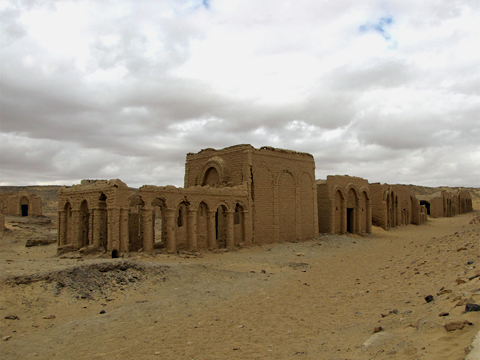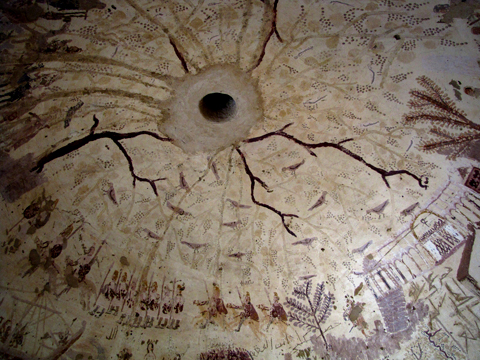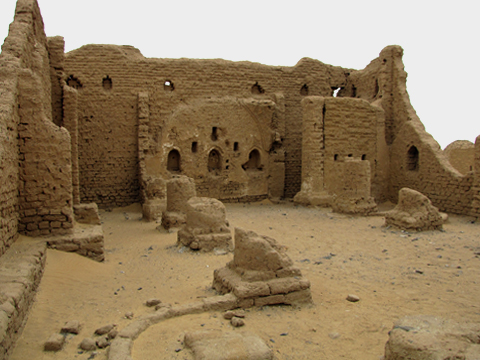Cemetery of El-Bagawat
About 3km from the centre of el-Kharga and 1km north of the Temple of Hibis is the early Christian cemetery of Bagawat. Sprawling up the lower southern foothills of Gebel el-Teir, Bagawat is perhaps the oldest major Christian cemetery in the world and has become a main tourist attraction for Kharga Oasis.

The cemetery consists of a vast expanse of domed mudbrick mausoleums and underground galleries dating back to the 4th century AD, which were built over the site of an earlier Egyptian necropolis of pit-graves. As a burial ground Bagawat appears to have been in constant use until the 11th century, although the mudbrick structures date only up to the 7th century. The architectural style of the 263 tomb-chapels varies from simple one-room structures to family mausoleums with ornate façades enhanced with faux columns and arches and domed roofs.

The chapels were arranged in ‘streets’ and interconnecting narrow alleyways, making this one of the earliest ‘cities of the dead’. Each superstructure was constructed over a deep pit beneath the floor level which contained shelves for the coffins and funerary goods. It is interesting that some of the equipment had been re-used from earlier Egyptian burials, with painted scenes of Horus and Thoth still visible. The early Christians of Kharga also continued with the ‘pagan’ custom of embalming their dead long after the tradition had been discontinued in other areas. Unfortunately virtually all of the tombs have been plundered over time and most of the mummies destroyed in the process.

Although many of the chapels were undecorated and consisted simply of a single chamber built over the tomb shaft, some were much more elaborate and contained plastered walls with painted biblical scenes in a strange mixture of styles while others have elements reminiscent of earlier Egyptian architecture.

Two of the most outstanding and best preserved of the decorated chapels are named ‘Chapel of the Exodus’ and ‘Chapel of Peace’. Inside the Chapel of the Exodus, which is one of the earliest in the cemetery, the interior of the dome is decorated in two bands illustrating scenes from the Old Testament; Adam and Eve, Moses leading the Israelites through the Sinai desert in the Exodus, Pharaoh (Rameses II?) and his armies, Noah’s ark, Daniel in the lion’s den, Jonah and the whale and several other biblical episodes. In the Chapel of Peace, similar themes are depicted on the dome, including the Annunciation of the Virgin Mary and others, each identified in Greek. The interior walls are also painted with many Byzantine frescoes of grape vines, peacocks, allegorical figures and inscriptions. The purpose of the Christian tomb-chapels, like their ancient Egyptian counterparts, was for the reverence of the deceased.

Numerous Arabic graffiti dating from the 9th century to the present day can also be seen in some of the chapels, including some by Turkish soldiers thought to be garrisoned at Bagawat in the late 18th century.

In the centre of the cemetery a mud-brick church once had Christian saints depicted on its walls and at the rear niches for icons and lamps can still be seen.
Nearby monuments
About 2km beyond the cemetery of Bagawat in an ancient limestone quarry in the foothills of Gebel el-Teir, there are numerous graffiti inscribed on the faces of rocks and boulders. The graffiti, written in Demotic, Greek and Coptic, span over seven centuries and date from Ptolemy VIII through the Greek and Roman periods to the Coptic Christian era. One Demotic graffito dating to the reign of Cleopatra VII mentions the ancient name of Kysis, which was the name of the town surrounding the fortress at Dush. Other areas of the wadis and slopes of Gebel el-Teir also contain graffiti dating from prehistoric to present times, but they are often difficult to access.
Also in the foothills behind Bagawat, a series of rock-cut tombs stretch for almost 1km in the side of the mountain. Although usually named as ‘Sixth Dynasty Tombs’ they are mostly unexcavated and show little evidence of belonging to the Old Kingdom.
Standing far out on the open plain west of Bagawat, is a tall mubrick tower known as Tahunet el-Hawa, or ‘Tower of the Winds’. The structure is presumed Roman although it has never been properly investigated or dated by archaeologists. Measuring roughly 6m by 6m at the base and rising almost 12m in height, it once contained several floors connected by a staircase and is thought to have been a watchtower or signal post. A single entrance on the south side gives access to the now-empty tower. Standing near the intersection of two important tracks, the structure may even have been used as a beacon to guide travellers along the desolate desert routes towards el-Kharga.
